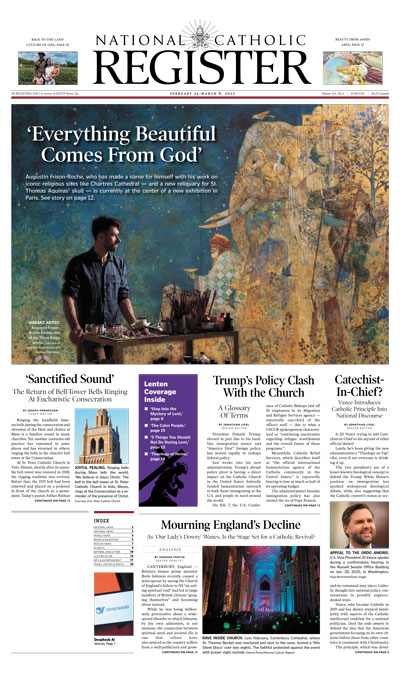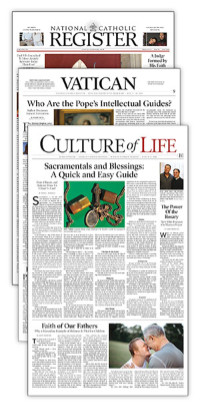A (Very Short) History of US Presidents Attending Papal Funerals
President Trump and first lady Melania Trump will be attending Pope Francis’ funeral on April 26. Not so long ago, that was a shocking idea.

Within hours of Pope Francis’ death Easter Monday, President Donald Trump told the world that he plans to attend his funeral.
“Melania and I will be going to the funeral of Pope Francis, in Rome. We look forward to being there!” the president said on Truth Social.
But not so many popes ago, such an announcement by an American president would have been unthinkable. For most of its history, the U.S. government sent no one to the funeral of the bishop of Rome.
In 1867, after decades of a formal U.S. presence in Rome, Congress voted to cut off funding for a diplomatic delegation to the Holy See, at a time when anti-Catholic sentiment was running high in the United States.
As recently as 1984, the two governments didn’t have formal diplomatic relations. Before then, even presidents who wanted to formally recognize the Holy See feared opposition within the United States.
President John F. Kennedy, the first Catholic president, encountered opposition on religious grounds during the 1960 campaign. Kennedy delayed a trip to Rome so that he wouldn’t be at Pope Paul VI’s coronation in 1963, and he made sure their first greeting would be a handshake, not the traditional kneeling and kissing of the Pope’s ring.
“It’s always worth remembering how deep anti-Catholicism runs in American history. For a long period in our history, it would have been very odd for the leader of the Catholic Church to be treated with the honor of the American president going to his funeral,” said Michael Moreland, professor of law and religion at Villanova University, told the Register.
Nowadays, though, the idea of a U.S. president attending the funeral of a pope — even one who had openly criticized him, as Francis did concerning Trump — isn’t that surprising.
“I think the change reflects the profound change in American attitudes towards the Catholic Church,” author and Catholic commentator George Weigel told the Register.
“The Protestant anti-Catholicism evident in the 1960 presidential campaign has gone into the dustbin of history. There’s a secular anti-Catholicism today, to be sure, but presidents have learned to ignore that with respect to events like a papal funeral,” said Weigel, author of Witness to Hope: The Biography of John Paul II (1999), and distinguished senior fellow and William E. Simon Chair in Catholic Studies at the Ethics and Public Policy Center.
Tables Turned
Father James Garneau, a U.S. Catholic historian, told the Register that the current solicitous stance of U.S. presidential administrations toward the Holy See has its roots in the often-fruitless diplomatic outreach of Pope Benedict XV a little more than a century ago.
The first sitting U.S. president to meet with a reigning pope was President Woodrow Wilson, who met with Pope Benedict XV in Rome in January 1919 — at the insistence of U.S. diplomats, and over his personal objections, according to John Dos Passos’ 1962 book Mr. Wilson’s War. Wilson, a Presbyterian, insisted that he spend the same amount of time with the rector of the American Episcopal Church in Rome as he did with the head of the Catholic Church.
“Remember, the Holy See was not invited to Versailles after World War I — and wanted to be there and was explicitly excluded by the European states,” said Father Garneau, referring to peace talks. “At that point, Wilson’s visit to the Holy See was seen as an advantage to the Holy See,” said Father Garneau, author of an academic journal article on the subject, “Presidents and Popes, Face to Face: From Benedict XV to John Paul II,” published in U.S. Catholic Historian in 2008.
“Since then, what you see is the development of the American president getting a photo op with the pope, as an advantage to the American state. The tables have turned entirely.”
In 1939, President Franklin Roosevelt appointed what he called a “personal representative” to Pope Pius XII. When Pius XII died in 1958, the Eisenhower administration sent Secretary of State John Foster Dulles and former ambassador Clare Booth Luce to Italy to attend a post-funeral requiem Mass for the Pontiff, according to newspaper accounts, in accord with Vatican protocol at the time.
When Pope John XXIII died in 1963, then-Vice President Lyndon Johnson attended the funeral — the highest-ranking member of the U.S. government to that point. (After he became president, Johnson insisted on meeting with John XXIII’s successor, Pope Paul VI, in New York City during the Pope’s visit to the United Nations in 1965, even though it raised diplomatic difficulties because the two governments did not have formal relations.)
In 1978, the year two popes died — Paul VI and John Paul I — President Jimmy Carter upped the ante, sending not only Vice President Walter Mondale but also the first lady, Rosalynn Carter, to Paul VI’s funeral.
Mondale also attended the funeral of the short-lived Pope John Paul I later that year.
‘A Great Deal of Open Dialogue’
John Paul I’s successor, St. John Paul II, had one of the longest reigns in papal history. President Ronald Reagan, who served during most of the 1980s, had an extraordinarily warm relationship with John Paul II, sharing U.S. intelligence with the Pontiff while consulting him in their shared opposition to Soviet communism in Poland and elsewhere.
In January 1984, while Reagan was running for reelection, the United States established formal diplomatic relations with the Holy See, sending a full ambassador to the Vatican.
Raymond Flynn, the first ambassador to the Holy See appointed by a Democratic president (Bill Clinton), in 1993, told the Register that his time in Rome saw “a great deal of open dialogue” between the U.S. government and the Vatican.
He said he believes that public opinion among Americans helps drive U.S. presidents into the arms of the Holy Father, whoever the president is and whoever the Holy Father is.
“It wasn’t so much the government. It was the people,” Flynn said. “The people of the United States were so interested in the Vatican’s concern for needy people, working-class people.”
Moreland, an expert on law and religion, noted a change in recent decades in Americans’ views of the Catholic Church and its leader when it comes to world affairs.
“I think, from the American standpoint, Catholicism up through the ’50s and ’60s and the election of John Kennedy as president, was an esoteric religion, and Catholics were not really accepted into the mainstream,” Moreland told the Register.
But popes since then have been widely accepted as worthy world figures, even though they rule a tiny amount of territory.
“Presidents now across the spectrum want to be seen as being accepted by and honoring the papacy,” he said.
‘Honor of a Lifetime’

When John Paul II died in 2005, President George W. Bush surprised the diplomatic world by announcing that he would attend the funeral — as he did with first lady Laura Bush, U.S. Secretary of State Condoleezza Rice, White House chief of staff Andy Card, and two former presidents, George H.W. Bush and Bill Clinton.
While John Paul had criticized the younger President Bush for invading Iraq and had tried to stop it, Bush praised him effusively.
The funeral of Pope Benedict XVI in January 2023 is an anomalous case, because Benedict had resigned almost a decade before, so he was not a head of state when he died. The Holy See invited only two state delegations — Italy and Germany — to the former Pontiff’s funeral. Even so, President Joe Biden’s press secretary felt the need to explain why the U.S. ambassador to the Holy See would be attending while Biden wouldn’t.
“This is what their requests were, this is what their wishes were, so that’s what you’re seeing from the U.S.,” Karine Jean-Pierre said during a White House press conference on Jan. 3, 2023, answering a question from Owen Jensen of EWTN News.
Occasional policy disagreements between popes and presidents do not seem to adversely affect the United States’ diplomatic posture toward the Holy See.
President Trump clashed with Pope Francis over immigration during Trump’s first term, and, more recently, and the two also disagreed on climate change, among other things.
But Trump also called meeting Pope Francis at the Vatican in May 2017 “the honor of a lifetime,” and when Pope Francis died on Monday, the president ordered flags at half-staff. Trump seems eager to attend the Pope’s funeral.
Flynn, who served as mayor of Boston before becoming U.S. ambassador to the Holy See, sees the actions of presidents toward popes as reflecting what many Americans want to see.
“The president, he’s not Catholic,” Flynn said. “But so many others are following closely what’s happening with the Church. They find hope there, what’s important in life — treating people with dignity and respect.”
- Keywords:
- u.s.-holy see relations















